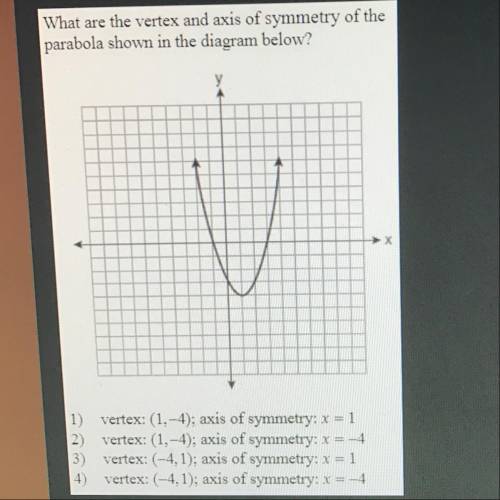What are the vertex and axis of symmetry of the
parabola shown in the diagram below?
1) verte...

Mathematics, 26.05.2021 19:20 eeeeee9848
What are the vertex and axis of symmetry of the
parabola shown in the diagram below?
1) vertex: (1.-4); axis of symmetry: x = 1
2) vertex: (1.-4); axis of symmetry: x = -4
3) vertex: (-4,1); axis of symmetry: x = 1
vertex: (-4,1); axis of symmetry: x = -4


Answers: 3


Another question on Mathematics

Mathematics, 21.06.2019 14:30
The contents of 3838 cans of coke have a mean of x¯¯¯=12.15x¯=12.15. assume the contents of cans of coke have a normal distribution with standard deviation of σ=0.12.σ=0.12. find the value of the test statistic zz for the claim that the population mean is μ=12.μ=12.
Answers: 1

Mathematics, 21.06.2019 14:30
An an average person has 6×10 by the power of two as many red blood cells as white blood cells a small sample of the blood has 7×10 by the power of three white blood cells about how many red blood cells are in the sample
Answers: 1

Mathematics, 21.06.2019 17:00
In tossing one coin 10 times, what are your chances for tossing a head? a tail? 2. in tossing one coin 100 times, what are your chances for tossing a head? a tail? 3. in tossing one coin 200 times, what are your chances for tossing a head? a tail? deviation = ((absolute value of the difference between expected heads and observed heads) + (absolute value of the difference between expected tails and observed tails)) divided by total number of tosses. this value should always be positive. 4. what is the deviation for 10 tosses? 5. what is the deviation for the 100 tosses? 6. what is the deviation for 200 tosses? 7. how does increasing the total number of coin tosses from 10 to 100 affect the deviation? 8. how does increasing the total number of tosses from 100 to 200 affect the deviation? 9. what two important probability principles were established in this exercise? 10. the percent of occurrence is the obtained results divided by the total tosses and multiplied by 100%. toss the coins 100 times and record your results. calculate the percent occurrence for each combination. percent head-head occurrence: percent tail-tail occurrence: percent head-tail occurrence:
Answers: 3

You know the right answer?
Questions


History, 18.01.2020 04:31

Mathematics, 18.01.2020 04:31


Mathematics, 18.01.2020 04:31

Mathematics, 18.01.2020 04:31





History, 18.01.2020 04:31

Computers and Technology, 18.01.2020 04:31


English, 18.01.2020 04:31


History, 18.01.2020 04:31

Biology, 18.01.2020 04:31

Mathematics, 18.01.2020 04:31




